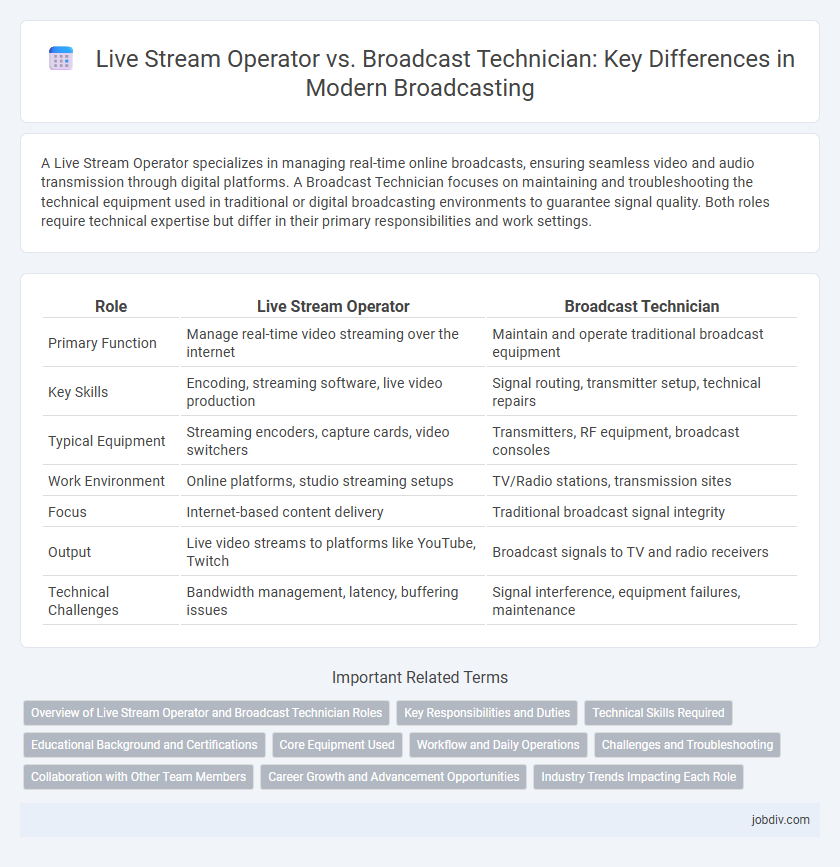A Live Stream Operator specializes in managing real-time online broadcasts, ensuring seamless video and audio transmission through digital platforms. A Broadcast Technician focuses on maintaining and troubleshooting the technical equipment used in traditional or digital broadcasting environments to guarantee signal quality. Both roles require technical expertise but differ in their primary responsibilities and work settings.
Table of Comparison
| Role | Live Stream Operator | Broadcast Technician |
|---|---|---|
| Primary Function | Manage real-time video streaming over the internet | Maintain and operate traditional broadcast equipment |
| Key Skills | Encoding, streaming software, live video production | Signal routing, transmitter setup, technical repairs |
| Typical Equipment | Streaming encoders, capture cards, video switchers | Transmitters, RF equipment, broadcast consoles |
| Work Environment | Online platforms, studio streaming setups | TV/Radio stations, transmission sites |
| Focus | Internet-based content delivery | Traditional broadcast signal integrity |
| Output | Live video streams to platforms like YouTube, Twitch | Broadcast signals to TV and radio receivers |
| Technical Challenges | Bandwidth management, latency, buffering issues | Signal interference, equipment failures, maintenance |
Overview of Live Stream Operator and Broadcast Technician Roles
Live Stream Operators manage real-time video streaming, ensuring seamless delivery of content across digital platforms through tasks like encoding, monitoring stream quality, and troubleshooting technical issues. Broadcast Technicians focus on operating and maintaining broadcast equipment, including cameras, audio systems, and transmitters, to support traditional television or radio broadcasts. Both roles require expertise in video and audio technology but differ primarily in the platforms and specific technical responsibilities they handle.
Key Responsibilities and Duties
Live Stream Operators manage the real-time transmission of video content, ensuring seamless streaming quality by monitoring audio-visual feeds, adjusting encoding settings, and troubleshooting live feed interruptions. Broadcast Technicians handle the technical equipment setup, maintenance, and operation in broadcast facilities, including cameras, switchers, transmitters, and audio systems, to guarantee signal integrity and compliance with broadcast standards. Both roles require expertise in video signal flow and equipment troubleshooting, but Live Stream Operators emphasize live content delivery, while Broadcast Technicians focus on the overall broadcast infrastructure.
Technical Skills Required
Live Stream Operators require expertise in streaming software, encoding settings, and real-time audio-visual troubleshooting to ensure seamless content delivery over the internet. Broadcast Technicians must possess advanced knowledge of broadcast signal flow, transmitter operations, and studio equipment maintenance for traditional television and radio broadcasts. Both roles demand proficiency in video switchers, audio mixers, and network technology, but Live Stream Operators focus more on IP-based solutions while Broadcast Technicians emphasize RF and signal processing skills.
Educational Background and Certifications
Live stream operators typically hold certifications in digital media production, video editing, and streaming technologies, often gained through specialized training programs or associate degrees in media studies. Broadcast technicians usually possess a more technical educational background, including degrees or certifications in electronics, telecommunications, or broadcast engineering, emphasizing hands-on experience with broadcast equipment and signal transmission. Both roles benefit from industry-recognized certifications such as Society of Broadcast Engineers (SBE) credentials or Adobe Certified Expert (ACE) for software proficiency.
Core Equipment Used
Live Stream Operators primarily rely on encoding software, cameras, audio mixers, and internet connectivity tools to facilitate seamless online broadcasting. Broadcast Technicians utilize more extensive equipment such as video switchers, transmitters, RF modulation gear, and satellite uplink systems to manage traditional television and radio transmissions. Both roles require expertise in audio and video signal processing but differ in the technical infrastructure supporting live streams versus broadcast networks.
Workflow and Daily Operations
Live Stream Operators manage real-time video feeds, ensuring seamless transmission, audio synchronization, and viewer interaction during digital broadcasts while monitoring streaming platforms for technical issues. Broadcast Technicians handle the setup, maintenance, and troubleshooting of broadcast equipment such as cameras, switchers, and transmitters, focusing on signal quality and hardware functionality for television or radio broadcasts. Workflow for Live Stream Operators emphasizes immediate content delivery and interactive audience engagement, whereas Broadcast Technicians prioritize equipment reliability and broadcast signal integrity in daily operations.
Challenges and Troubleshooting
Live Stream Operators face challenges such as managing real-time encoding, ensuring low-latency delivery, and troubleshooting bandwidth fluctuations to maintain uninterrupted streaming quality. Broadcast Technicians handle complex signal routing, equipment calibration, and resolving hardware failures to support seamless transmission across various media platforms. Both roles require quick decision-making and technical expertise to address unexpected issues and minimize downtime in high-pressure broadcast environments.
Collaboration with Other Team Members
Live Stream Operators coordinate closely with content creators and digital teams to ensure seamless real-time delivery and interactive audience engagement. Broadcast Technicians collaborate with engineers and production crews to maintain equipment functionality and signal quality throughout the broadcast. Both roles require effective communication to synchronize technical operations and creative elements for a successful live broadcast.
Career Growth and Advancement Opportunities
Live Stream Operators often experience rapid career growth due to the expanding demand for digital content, gaining specialized skills in streaming technology, content management, and audience engagement analytics. Broadcast Technicians benefit from a broader foundation in traditional television and radio infrastructure, offering advancement opportunities into network engineering, facilities management, and broadcast system design. Both roles require continuous upskilling, but Live Stream Operators align closely with evolving platforms, while Broadcast Technicians maintain essential expertise in complex, large-scale broadcast environments.
Industry Trends Impacting Each Role
Live stream operators face increasing demand for real-time content delivery across diverse platforms, necessitating expertise in adaptive streaming technologies and interactive viewer engagement tools. Broadcast technicians must adapt to the integration of IP-based workflows and automation systems, emphasizing skills in network management and remote production setups. Both roles evolve with trends toward cloud-based broadcast solutions and higher resolution formats, driving continuous technical upskilling in a competitive media landscape.
Live Stream Operator vs Broadcast Technician Infographic

 jobdiv.com
jobdiv.com